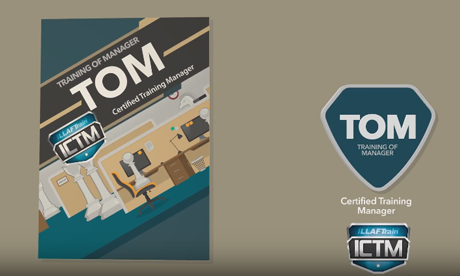Certified Training Manager
Course Code TOM
Duration 6 Days / 48 Hours
Fees 2690 $
Introduction
In your capacity as training manager, in this program you will learn the practical methods, voice techniques and the ideas that proved to be effective for the institutional training management ensuring concrete and final results. This program helps the training managers to prepare themselves to be effective producers through their work results, in addition to developing the policies and procedures necessary to ensure the suitability between the initiatives, learning interventions and work needs, the support from the senior executives, providing efficient and effective administration, linking learning to a measurable tool and expanding the scope of what is provided by the post-training department in official classrooms.
Who is this program for?
For training managers who want to deal with the challenges facing training management these days and to any person responsible for training management.
Program’s objectives
At the end of this training program, each learner will be able to:
- Distinguish the training function objective within a changing organizational environment.
- Develop the vision, mission and function of the statement of priorities.
- Determine how to use the management systems’ checking tools to measure his own function, and identify the development areas.
- Use eight steps in the consulting process.
- Determine the most appropriate learning techniques that provide business return.
- Use techniques to anticipate the changing training needs in the institution.
- Determine when to use eight types of evaluation tools to identify the training needs.
- Use a ten-step model to ensure the introduction of learning within the business.
- Determine the appropriate learning techniques.
- Create an environment for efficient learning.
- Develop the coaching and influencing skills.
- Determine the difference orientations in training and development.
- Verify the effectiveness of learning activities and training techniques.
- Practice how to get the management’s commitment to improving performance.
- Use a nine-part plan to build agreements and work successfully with the executive managers and employees.
- Distinguish how to work to achieve results, not only training activities.
- Determine the basic components of the performance improvement plan.
- Determine the techniques necessary for marketing his own training function.
- Evaluate the supervision and development of the employees’ training using one hundred efficiency tools.
- Create a work plan to achieve results.
- Use four basic techniques to prepare learners for training.
- Identify the techniques to rationalize the training cost and monitor the training budget in classrooms and training programs via the Internet.
What You Will Learn?
Training Function Management
The recent trends in training.
Identifying the basic roles in training and development.
Determining and setting the priorities of your vision, mission and training function.
Tips to maintain your discipline for being an individual in the group.
Performing the review systems of the training department.
Managing and developing the training employees.
Strategic Partnership
Business strategy, organizational development strategy and human resources development strategy.
Five factors of management strategies.
Derivation of learning objectives from business objectives.
Frameworks capabilities.
Arranging the priorities and providing the resources.
Gaining the support of senior management.
The Need for a Total System
The transition from vision to evaluation.
The ten-step model.
Developing an organized learning plan.
Analyzing the issues and creating solutions.
Internal Consulting Skills
Determining your place in the management training’s life cycle.
Balancing between the traditional training and the performance consulting techniques.
Using a continuum of internal consulting roles.
Analyzing your role in the organization.
Determining your clients.
Using the eight-step consulting process.
Distinguishing between the trainer, the consultant and the change leader.
Identifying Training Needs
The needs of companies, the management and the team, in addition to individual needs.
Managing change, leadership and performance.
Providing flexibility in the processes of determining training needs.
Finding efficient and appropriate solutions for interventions.
Analyzing the issues and creating solutions.
Measuring Performance and Improvement
The design initiatives.
The communications channels.
The self-growth knowledge system.
Evaluating the human resources department function.
The basic performance indicators.
Verifying the validity of interventions.
Evaluation and return on investment.
Human Resources Development Manager
The management performance principles.
Determining the objectives, measuring the performance and providing feedback.
Critical thinking, finding solutions and taking decisions.
The role of leadership in human resources development.
Analyzing the issues and creating solutions.
Gaining the support of the executive managers.
Diagnosing the Problems
Determining the assessment problems.
Studying the manager role using eight tools to control the training department.
Identifying if training is the solution.
Making vague training more accurate.
Sorting the training needs and the things we want.
Using the training design tools to diagnose the problems.
Creating the Plan
Determining the ten performance components to improve the plan.
Determining if the available materials will be used or if new materials will be created.
Determining standards to review the training suggestions.
Using a tool to balance among the training techniques.
Creating a Partnership with the Management and Learners
Ensuring your style of influence.
How to establish credibility with executive managers.
How to be more responsive to the organization.
Increasing your power of influence on others.
Applying strategies to promote the program efficiently.
Developing the tripartite partnerships.
Transfer of Learning
Defining the transfer of learning.
Determining the obstacles that prevent the transfer of learning.
Identifying who will take charge of the application of what has been learned previously.
Discovering four basic tactics to build the groundwork before training.
Reviewing the post-training analysis.
Clarifying how to involve pre-training managers.
Eight basic tips to prepare the employee before training and follow up with him after it.
The extent of the manager’s influence in providing criticism.
How to perform an evaluation of the learning transfer measurement.
Techniques to determine the expectations that work on the improvement and retention of learning.
Developing work plans to keep everybody on the right track.
Budget Management
How to determine the training cost.
Creating a structure for the training cost.
Performing the analysis of costs and return on investments.
Finding the performance indicators to prove the benefit of training.






